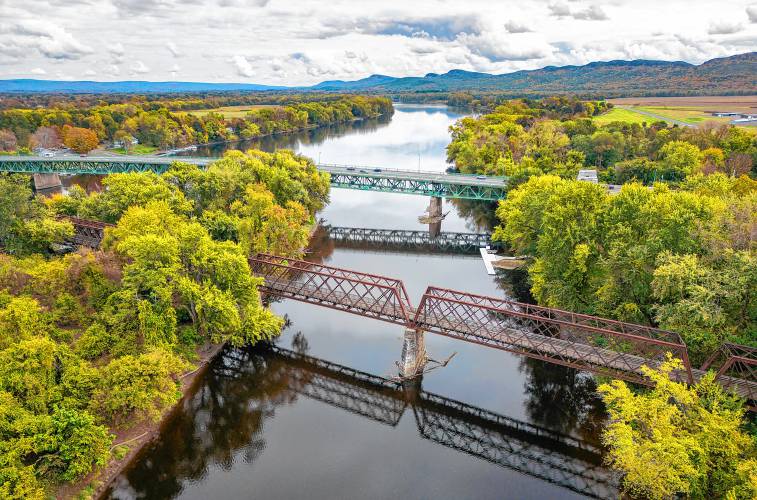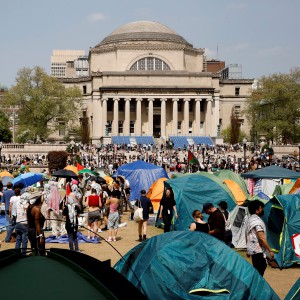Guest columnist Kristin DeBoer: Let’s stand together for the valley you love

The Connecticut River looking south over the Norwottuck Rail Trail Bridge and the Calvin Coolidge Bridge between Northampton and Hadley. STAFF FILE PHOTO
| Published: 04-01-2025 2:49 PM |
As enormous waves of news from Washington continue to flood the country, you may be worried about how all these changes will affect local lands and waters.
Fortunately, the Valley’s conservation community is resourceful and resilient. Together, nonprofits, municipalities and state agencies can find smart ways to stay the course and become even more effective, even as the federal landscape shifts.
First, let’s recap what’s changed since January. Abrupt federal job cuts and office closures have sown chaos at the U.S. Fish & Wildlife Service in Hadley and the U.S. Department of Agriculture in Amherst. This uncertainty threatens to diminish the important role these wildlife, fisheries, and agricultural experts have in our communities.
Federal funds have been frozen and other cutbacks are looming, stalling opportunities to protect local forests. Critical reimbursements for agricultural improvements have been withheld, leaving small farms in the lurch. Federal environmental and climate justice programs have been eliminated, undermining efforts to provide equitable access to clean water and nearby parks and trails.
Finally, the administration’s abandonment of climate solutions and its drive to expand fossil fuel extraction on public lands jeopardize the health of our ecosystems.
There is no doubt that these federal edicts have shaken the ground we stand on. However, in the face of adverse federal conditions, the Valley’s conservation movement can become stronger — if we stand together, community by community, farm by farm, forest by forest.
To start with, we can advocate for two sources of federal funding that have a fighting chance due to historic bipartisan support. The U.S. Farm Bill provides funds to bolster local and state investments in farm protection and upgrades. The U.S. Land and Water Conservation Fund (LWCF) provides grants for conservation of forests and waters, including within the Silvio O. Conte National Fish and Wildlife Refuge here.
Article continues after...
Yesterday's Most Read Articles
Funding from the LWCF has been used to protect lands up and down the Connecticut River Watershed, with the support of local land trusts and the U.S. Fish & Wildlife Service. Through this effort, beloved public lands at the Fort River in Hadley, the Mill River in Northampton, the Dead Branch in Williamsburg, and Fannie Stebbins in Longmeadow are open to everyone. Tens of thousands of people visit each year.
Nearly every farm that has been protected in the Valley has relied on federal funding, leveraging state and local support through the Massachusetts Agricultural Preservation Restriction Program. These farms grow local food, support the rural economy, and are at the heart of community-supported agriculture.
A bill introduced by U.S. Rep. Jim McGovern, the Connecticut River Watershed Partnership Act, would support partnerships between government and nonprofits to promote conservation, restoration, education, and recreation efforts in the watershed. This is what democracy looks like — shared commitment and responsibility.
We can all urge Congress to stand strong on conservation as a long-standing shared American value.
Meanwhile, at a state and municipal level, we can increase local investments to become more self-reliant. Here are some ways to begin:
■Contact Gov. Marua Healey to encourage Massachusetts to continue its leadership on climate and biodiversity solutions, by passing a strong Environmental Bond Bill for the next five years.
■Urge your town to make full use of the Community Preservation Act (CPA), which provides funding for open space and historic sites, affordable housing and outdoor recreation. A vote to adopt or reauthorize a modest 1-3% local surcharge on real estate property creates the fund, which town meeting then chooses how to spend.
■If you are a landowner, consider donating conservation restrictions to protect family land forever, in exchange for charitable state tax credits. Everyone can urge our state Legislature to pass SD.203/ HD.1347 to raise the annual cap on these incentives.
Massachusetts is renowned for investing in the conservation of its lands and waters. And the Valley has one of the hardest-working conservation communities in the commonwealth, thanks to generous contributions from so many residents of their money and their time.
Kestrel Land Trust, for one, is undaunted in our mission. We will continue to stand up to protect the Valley you love — working together with all who care about the lands and waters that are the foundations of our daily lives.
Kristin DeBoer is executive director of the Kestrel Land Trust.






 Guest columnist Teresa Amabile: Undermine education, undermine our future
Guest columnist Teresa Amabile: Undermine education, undermine our future Guest columnist Liz Brown: Abortion care is health care
Guest columnist Liz Brown: Abortion care is health care D. Dina Friedman: Jewish group decries ICE’s crackdown on freedom of speech
D. Dina Friedman: Jewish group decries ICE’s crackdown on freedom of speech Henry Lappen: Tango is alive and well in the Valley
Henry Lappen: Tango is alive and well in the Valley
